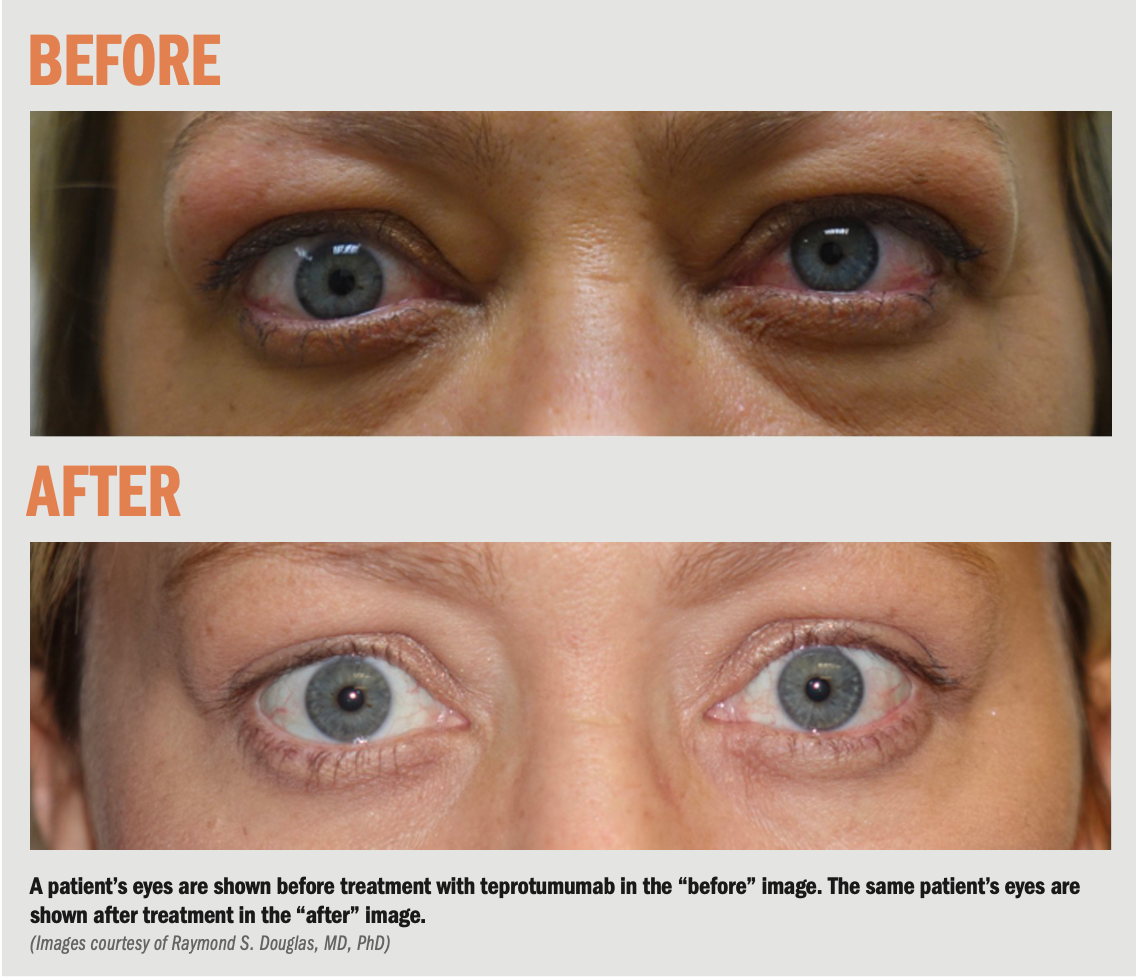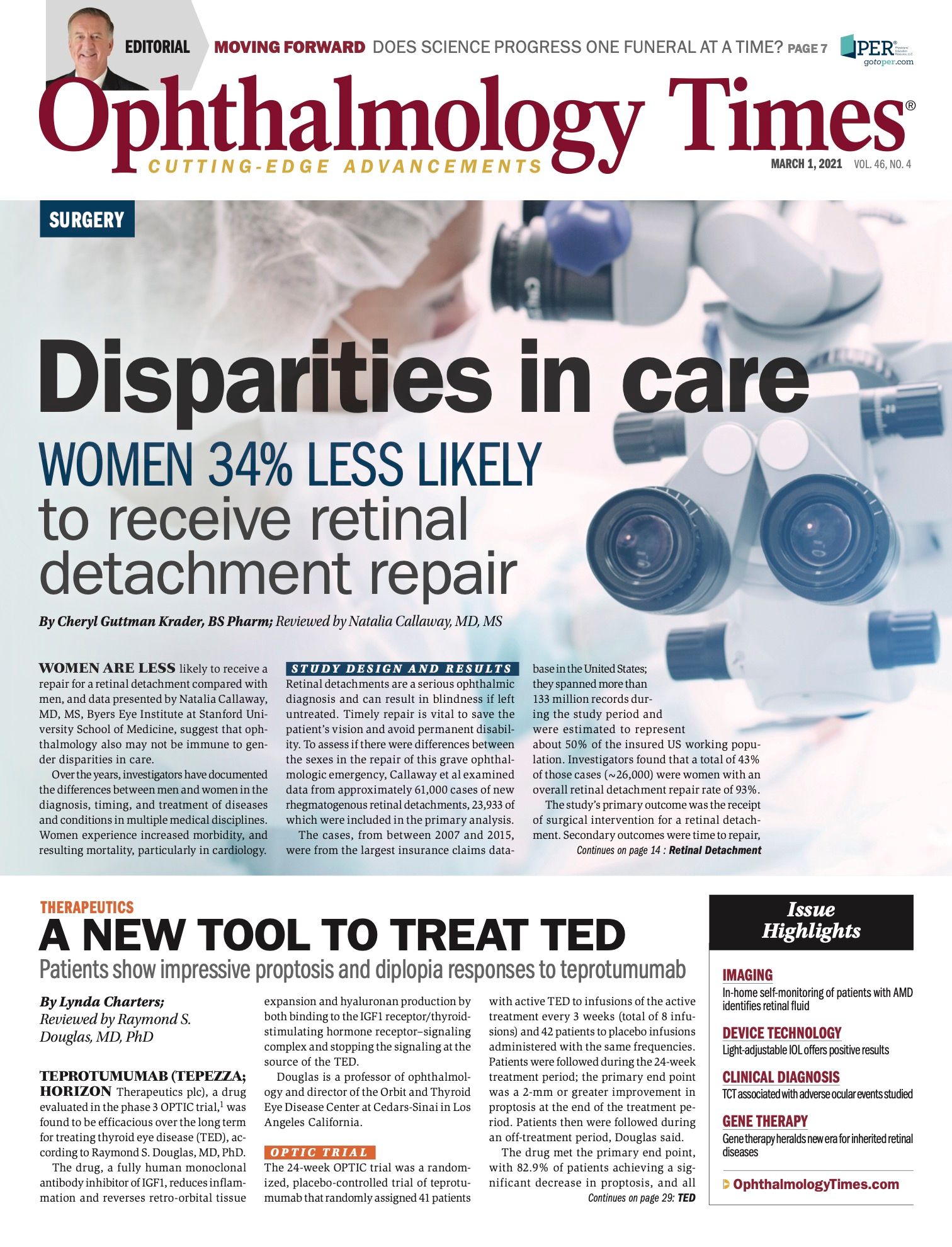Publication
Article
Digital Edition
A new tool to treat TED
Author(s):
Patients show impressive proptosis and diplopia responses to teprotumumab.


This article was reviewed by Raymond S. Douglas, MD, PhD
Teprotumumab (Tepezza; Horizon Therapeutics plc), a drug evaluated in the phase 3 OPTIC trial,1 was found to be efficacious over the long term for treating thyroid eye disease (TED), according to Raymond S. Douglas, MD, PhD.
The drug, a fully human monoclonal antibody inhibitor of IGF1, reduces inflammation and reverses retro-orbital tissue expansion and hyaluronan production by both binding to the IGF1 receptor/thyroid-stimulating hormone receptor–signaling complex and stopping the signaling at the source of the TED.
Related: Thyroid eye disease: Not limited to visual impairment
Douglas is a professor of ophthalmology and director of the Orbit and Thyroid Eye Disease Center at Cedars-Sinai in Los Angeles California.
OPTIC trial
The 24-week OPTIC trial was a randomized, placebo-controlled trial of teprotumumab that randomly assigned 41 patients with active TED to infusions of the active treatment every 3 weeks (total of 8 infusions) and 42 patients to placebo infusions administered with the same frequencies.
Patients were followed during the 24-week treatment period; the primary end point was a 2-mm or greater improvement in proptosis at the end of the treatment period. Patients then were followed during an off-treatment period, Douglas said.
The drug met the primary end point, with 82.9% of patients achieving a significant decrease in proptosis, and all secondary end points, such as improved inflammation, diplopia, and quality of life (P ≤ 0.001 for all comparisons).
Related:
The investigators then sought to determine if the beneficial results were maintained over the long term. The 34 patients who responded to teprotumumab were evaluated during the off-treatment follow-up period.
“Maintained responders” were defined as those patients who continued to meet the 24-week response definition and received no additional TED treatment at the time of the 72-week visit, Douglas explained. This continued during the study.
“We found that 56% of patients who were responders at week 24 were still responders at week 72,” he said.
Douglas also explained that the 15 patients who did not meet the definition of a maintained responder at week 72 fell into one of the following categories: discontinued the study prematurely (n = 4); worsened slightly but not enough to qualify for the open-label, extension study OPTIC-X (n = 2); or qualified for OPTIC-X because of flare before the 72-week time point (n = 9).
At the final follow-up evaluation, 73% had an improvement in proptosis.
Related:
What about retreatment?
The patients who did not have an initial response to teprotumumab with reduced proptosis had the option of enrolling in the OPTIC-X study and undergoing another 8 infusions of teprotumumab and evaluation at 24 weeks.
Douglas reported that during the second course of the drug, 62.5% (n = 8 for whom data were available) of patients responded and had marked reductions in proptosis (–1.9 mm at 24 weeks).
The overall decrease in proptosis from the OPTIC baseline was significant (–3.3 mm at week 24 of the OPTIC-X study).
This result prompted the investigators to determine if nonresponders can benefit from more infusions of teprotumumab.
Related: As COVID-19 focuses attention on vaccine, medication shortages loom
Specifically, the 5 nonresponders in the OPTIC study went on to receive the drug again in the OPTIC-X study.
At week 24 of the OPTIC-X study, 2 were responders, 1 was a nonresponder, and 2 were not measured and therefore considered nonresponders. The results for these 5 patients demonstrated the residual benefit from a second treatment course.
Treating disease
The investigators wanted to know if a longer disease duration impacted the response to teprotumumab.
Thirty-six patients randomly assigned to placebo were nonresponders and eligible for enrollment in OPTIC-X for a course of active drug; these patients were approximately 1 year out from the point at which TED was diagnosed (compared with a TED diagnosis of approximately 6 months in those randomized to teprotumumab initially in the OPTIC study).
Related: Study reduces proptosis, diplopia in TED
According to investigators, the study also examined the efficacy ad various points in treatment during the trial, and investigators said they were pleased with the results that they received.
When the efficacy was evaluated at 24 weeks, Douglas reported that the proptosis response was almost identical to that in the OPTIC study—in that 89.2% of patients who were initially randomized to placebo and went on to active treatment had a proptosis response.
Improvement rates
The rates of improvement of diplopia in the 2 groups also were similar: 67.9% in the teprotumumab arm of the OPTIC study and 60.9% in the placebo-to- teprotumumab group in the OPTIC-X study.
The trend also carried through the efficacy of the candidate, according to investigators.
The safety of teprotumumab in the phase 3 study was the same as in the phase 2 study; one patient had a serious adverse event during the second treatment course that was unrelated to active treatment.
Related: Considering use of teprotumumab in thyroid eye disease patients
Conclusion
Douglas concluded that most of the patients who responded to active treatment at week 24 of the phase 3 study were still responders at week 72 without receiving any additional TED treatment.
“No new safety signals were identified. Regarding the patients who did not respond to teprotumumab during the OPTIC study, many had improvements in proptosis during the OPTIC-X study, with a similar safety profile,” Douglas pointed out. “OPTIC-X data provided evidence that supported the use of teprotumumab in patients who had had TED for a longer time than that studied in the phase 2 and 3 clinical trials.”
-
Raymond S. Douglas, MD, PhD
e:raymonddouglasmd@gmail.com
Douglas is a consultant for Horizon Therapeutics.
--
Reference
1. Douglas RS, Kahaly GJ, Patel A, et al. Teprotumumab for the treatment of active thyroid eye disease. N Engl J Med. 2020;382(4):341-352. doi:10.1056/NEJMoa1910434

Newsletter
Don’t miss out—get Ophthalmology Times updates on the latest clinical advancements and expert interviews, straight to your inbox.




